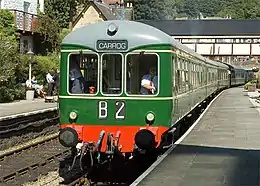| British Rail Class 109 | |
|---|---|
 Preserved unit 50416+56171 | |
| In service | 1957–1971 |
| Manufacturer | D. Wickham and Company |
| Family name | First generation |
| Replaced | Steam locomotives and carriages |
| Constructed | 1957–1958 |
| Number built | 5 sets |
| Number preserved | 1 set |
| Formation | 2-car sets: DMBS-DTCL |
| Capacity | DMBS: 59 second, DTCL: 16 first, 50 second |
| Operators | British Rail |
| Specifications | |
| Car length | 57 ft 0 in (17.37 m) |
| Width | 8 ft 3 in (2.51 m) |
| Height | 12 ft 4+1⁄2 in (3.77 m) |
| Maximum speed | 70 mph (113 km/h) |
| Weight | DMBS: 27 long tons 0 cwt (60,500 lb or 27.4 t) DTCL: 37 long tons 10 cwt (84,000 lb or 38.1 t) |
| Prime mover(s) | 2 x British United Traction Leyland |
| Engine type | 6 cylinder horizontal |
| Power output | 2 x 150 bhp (110 kW) |
| Transmission | fluid coupling and air operated 4-speed epicyclic gear box |
| UIC classification | 1A′A1′+2′2′ |
| Bogies | standard Derby 8 feet 6 inches (2.59 m) wheelbase |
| Braking system(s) | Vacuum |
| Coupling system | Screw-link; British Standard gangways |
| Multiple working | ■ Blue Square |
| Track gauge | 4 ft 8+1⁄2 in (1,435 mm) standard gauge |
The British Rail Class 109 is a class of 2-car diesel multiple units built in 1957 by D Wickham & Co. Five two-car units were built featuring an unusual body design. The design, first used in 1936 for South American railways, aimed to minimise weight. It had no underframe, but the whole body was formed into a welded stress-bearing box girder made of 1⁄8 inch (3.2 mm) solid drawn steel tube. Aluminium was used for panels, luggage racks, window frames, vacuum pipes and fuel and vacuum tanks. The corrugated steel floor was filled with sprayed asbestos and covered with asbestos-filled flame-proofed hardboard and rubber sheet.[1]
The units soon became non-standard and two were sold back to the manufacturer who exported them to Trinidad and Tobago. Another unit was converted into departmental service, and survived in BR ownership until the early 1980s.
Vehicle numbers
| Lot No. | Diagram | Car Type | Qty | Fleet No. | Seating | Weight | Notes |
|---|---|---|---|---|---|---|---|
| 30288 | 606 | Driving Motor Brake Second (DMBS) | 5 | 50415–50419 | 59 second | 27 long tons 0 cwt (60,500 lb or 27.4 t) | |
| 30289 | 607 | Driving Trailer Composite with lavatory (DTCL) | 5 | 56170–56174 | 16 first (2+2), 50 second (2+3) | 22 long tons 10 cwt (50,400 lb or 22.9 t) |
Further use
One two-car set (50416+56171) was extensively overhauled in 1967 at Doncaster, revamping the interiors and adding kitchen facilities to 50416. After repainting, the set was used as the ER General Managers special train, numbered 975005 / 975006.[3]
Preservation
One two-car unit, (see above) the former departmental unit, formed of vehicles 50416 and 56171, has been preserved and restored to working condition at the Llangollen Railway. It was restored using lottery money.[4]
| Set number | Vehicle numbers | Livery | Location | Notes | |
|---|---|---|---|---|---|
| DMBS | DTCL | ||||
| - | 50416 | 56171 | BR Green | Llangollen Railway | Operational |
References
- ↑ Railway Magazine September 1957 pp. 606-608
- ↑ "Numbering of the Class 109s". www.railcar.co.uk. The Railcar Association. Archived from the original on 12 October 2008.
- ↑ "Non-passenger use of the Class 109s". www.railcar.co.uk. The Railcar Association. Archived from the original on 13 October 2008.
- ↑ "Preservation of the Class 109s". www.railcar.co.uk. The Railcar Association. Archived from the original on 5 September 2008.